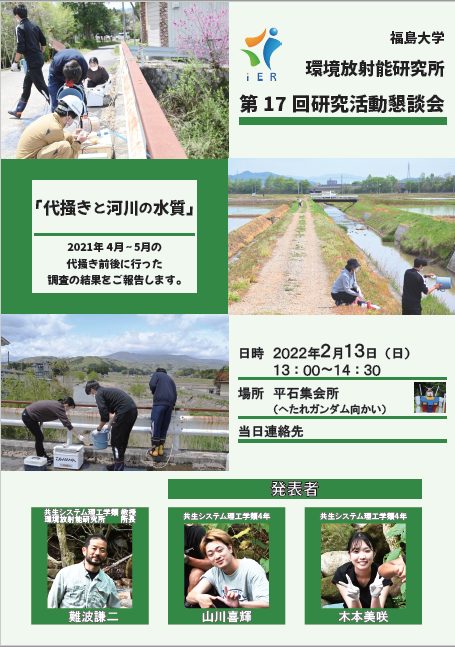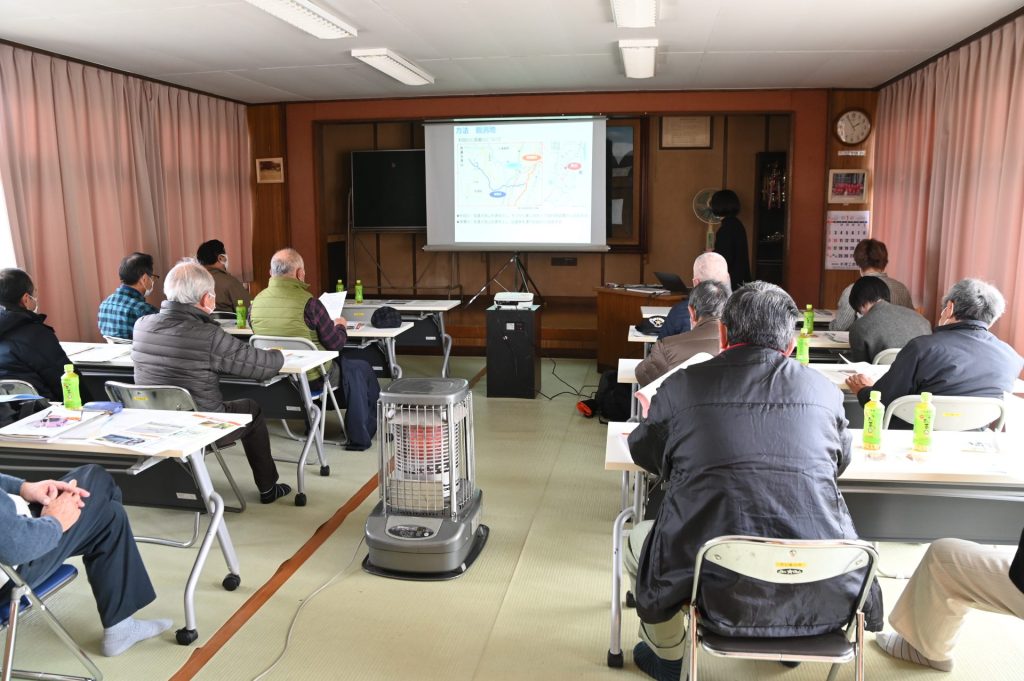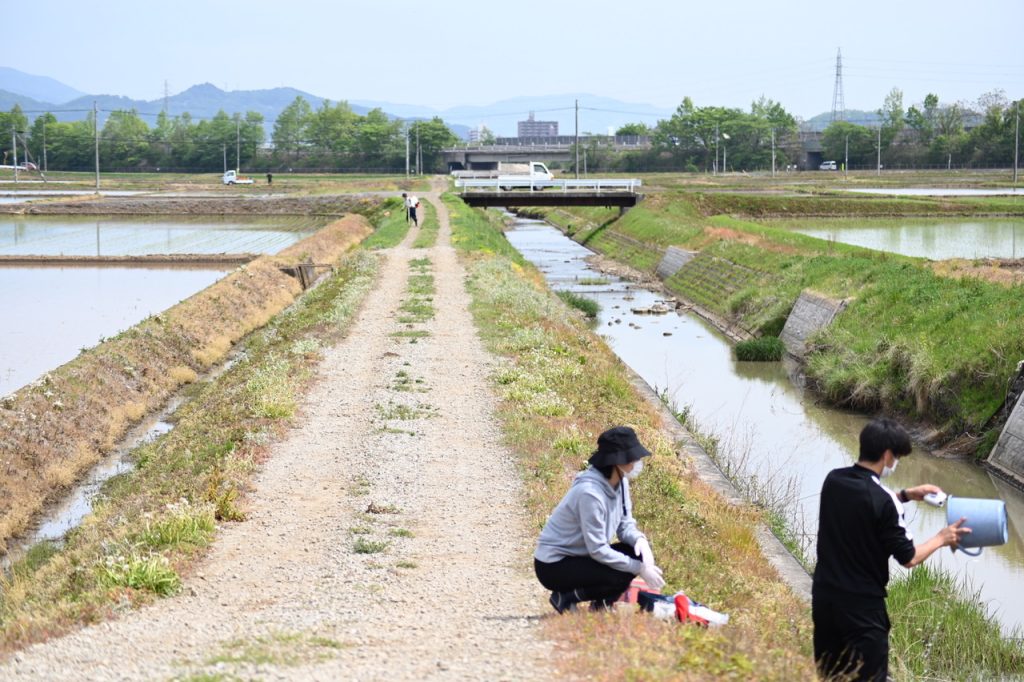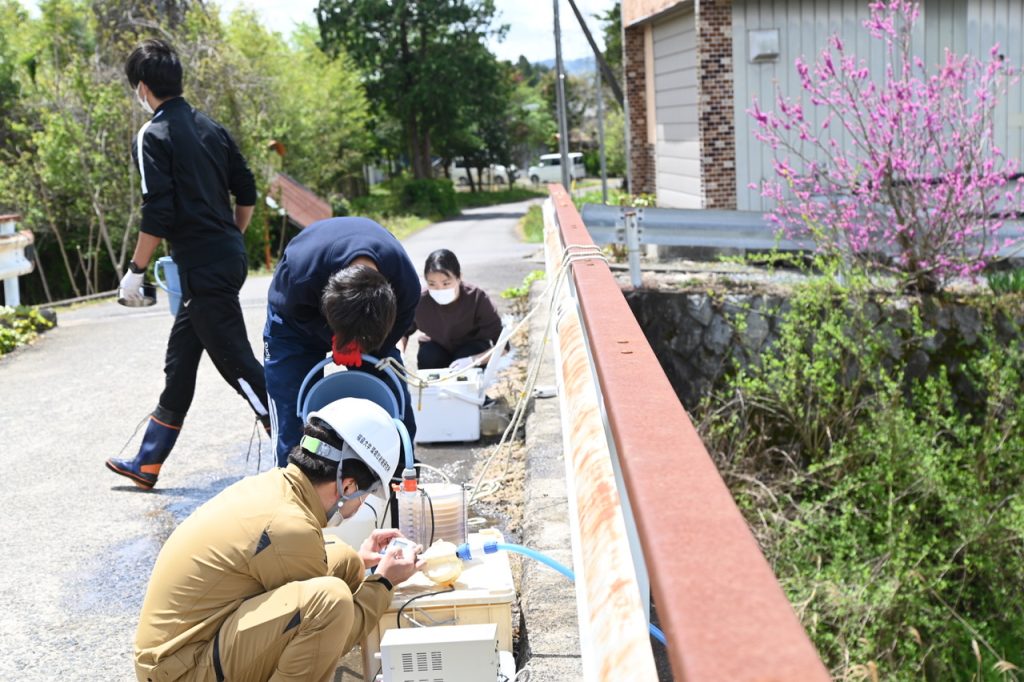February 13, 2022 17th Dialog meeting was held at Hiraishi community hall in Fukushima City
Date
Sunday, February 13, 2022, 1:00pm-2:30pm
Venue
Hiraishi community hall in Fukushima City
Topics
●Presence of suspended 137Cs in the Abukuma River
(YAMAKAWA Yoshiki: Senior student, Faculty of Symbiotic Systems Science, Fukushima University)
●Seasonal variation of 137Cs in river water originating from forest and agricultural land
(KIMOTO Misaki: Senior student, Faculty of Symbiotic Systems Science, Fukushima University)
●Question session
(NANBA Kenji/ Director of IER, and Professor, Faculty of Symbiotic Systems Science, Fukushima University)

Since 2016, we have been organizing dialog meetings to feedback our research results to local communities. In the 17th dialog meeting, two senior students of the Faculty of Symbiotic Systems Science Fukushima University, YAMAKAWA Yoshiki and KIMOTO Misaki, who are preparing batchelrs’ thesis under the supervision of Prof. Nanba, presented their research under the theme of “Evaluation of radiocesium runoff into rivers due to “Shirokaki” (a preparation process of paddy fields before planting rice seedling) in Fukushima Prefecture” YAMAKAWA’s theme of graduation thesis is “Morphology of suspended 137Cs in the Abukuma River” and KIMOTO has been working on the theme of” Seasonal variation of 137Cs in river water originating from forest and agricultural land” with the cooperation of professors at the IER (Dr. Igarashi, project assistant professor, and others). In this meeting, they reported on some of their research results and exchanged opinions with 10 participants from Hiraishi district of Fukushima City who helped them with their research in 2021 and 4 participants from Shimotoriwata district of Fukushima City who helped them in 2020. They have succeeded the research theme from MORITAKA Shota, who gave a presentation at the 14th dialogue meeting held in the Shimotoriwata in 2020.
Based on the observations conducted regularly at Kuroiwa, Fukushima City since 2012, YAMAKAWA explained that the concentration of dissolved radiocesium shows seasonal fluctuations with high levels in summer and low levels in winter, while there has been a long-term decreasing trend. He also explained that there is a particularly sharp increase in May every year. Since this rise in May suggests the possibility that radiocesium may be washed off into the river caused by Shirokaki activity, in 2020, he studied on muddy water appears in the paddies during Shirokaki in Shimotoriwata area, and in 2021, on how the water quality of the related waterways to the paddies changes before and after Shirokaki in the Hiraishi area. He shared the results indicating that the turbidity and 137Cs concentrations in the rice paddies during the Shirokaki were diluted to about 30 times before flowing into the waterways.
KIMOTO reported on a study she conducted that aimed to understand the impact of forests in addition to the impact of Shirokaki. The 137Cs concentration and water quality were compared between the observation points upstream of the Sugita River, where there are only forests, and downstream, where there are rice paddies. Upstream, approximately 80 % or more of the 137Cs in the river water was in dissolved form, while the ratio of suspended form increased downstream. However, the concentrations of dissolved 137Cs in the downstream were higher than those in the upstream in all seasons, and in particular, the concentrations of dissolved 137Cs in the downstream were 5 to 10 times higher than upstream concentrations on the days when Shirokaki was conducted. The results of the study indicated that although there is 137Cs runoff from forests, its contribution to the downstream was small, and that runoff from paddy fields during Shirokaki is considered to be a major contributor to the suspended and dissolved 137Cs concentrations in the downstream river water.
After the presentations, Director NANBA joined in the Q&A session. Participants asked questions such as, “Is the concentration of radioactive cesium in the river at a level that cannot be considered safe?” “I thought that radiocesium should be firmly adsorbed in the soil.” “How much radiocesium in the rice paddies is washed off?” and “What is the situation of radiocesium in the reservoirs upstream?” In response to the questions, “Even the highest concentration of dissolved 137Cs observed is 0.02 Bq/L, which is not a concentration that poses a safety problem,” and “The movement of substances such as potassium around the paddy fields, which is visible due to the presence of radiocesium, may give us a hint.” The valuable questions and comments we received will be used in our future research at the IER.
(Note) Since 2012, Fukushima Prefecture has implemented measures to prevent radiocesium absorption by rice plants by applying zeolite and potassium fertilizer before planting seedlings, and all brown rice harvested in the prefecture was inspected in bags. Since there were no cases exceeding the standard for five years since 2015, only the samples of harvested brown rice have been inspected from 2020.



